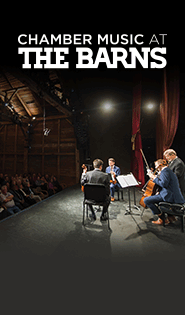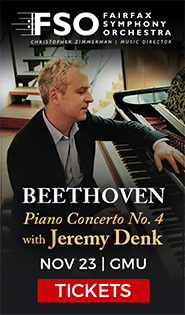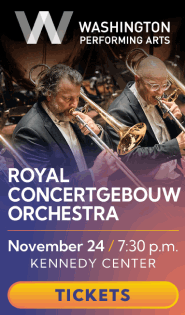Dramatic dissonance makes for a tone-deaf “Listeners” premiere at Opera Philly
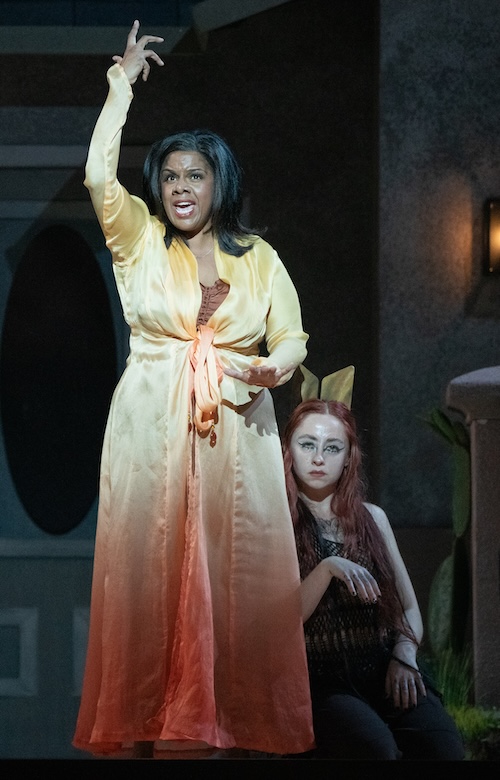
Nicole Heaston (with Sydney Donovan) stars in Missy Mazzoli’s. The Listeners at Opera Philadelphia. Photo: Steven Pisano
Opera Philadelphia’s 2024-2025 season kicked off Wednesday night with the American premiere of The Listeners, the fourth collaboration between composer Missy Mazzoli and librettist Royce Vavrek. Mazzoli and Vavrek’s second collaboration, 2016’s Breaking the Waves, first performed at Opera Philadelphia, holds a strong claim to being the best American opera of the last 20 years.
Unfortunately, this new offering will not be competing for that title.
There is a strong sense of promise about the opening ten minutes of the piece. We first hear three characters videotaping intimate confessionals (sung by Joseph Lim, Diana Newman, and John Moore), videos of their faces blown up in high definition on a massive scrim. Each snippet of text is pregnant with mystery and embroidered by disarming images in Vavrek’s libretto (from an original story by Jordan Tanneahill).
The scrim rises and singers fill the stage in a haunting, frenzied, chorus about a dreaded “hum” which afflicts them, underscored with spooky figures in the strings that hint at fragments of 1950s monster movie themes, disaggregated through a cacophony of orchestral effects. The chorus disperses and we hear Nicole Heaston, in a soaring opening aria as suburban schoolteacher Claire, who is also tortured by the hum. Heaston’s formidable stage presence and steely soprano are set against a strange, arresting tableau of a suburban driveway and skulking coyote (danced by Sydney Donovan) that seems like a figment of Claire’s imagination.
From that intriguing start, Act I turns to a fairly straightforward progression of scenes in which Claire loses her job, becomes alienated from her family, and finds out about a shadowy “community action group” for sufferers of the hum. There are still some captivating sequences here, like the climactic scene in Claire’s classroom, or the first aria for Kyle, a student who hears the hum too and begins a boundary-crossing relationship with Claire. Beautifully realized by Aaron Crouch’s limpid tenor (a standout last year in Washington National Opera’s Blue), Vavrek’s poetry memorably brings across the character’s disaffection.
But poetry is less in evidence as the First Act wears on, with mundane dialogue and a predictable sitcom logic crowding out any sense of surprise. These scenes dutifully advance the plot and provide exposition but offer little justification for why they need to be sung. Mazzoli’s score tries to enliven the vocal writing with shocking effects, like the high notes impressively executed by soprano Lindsey Reynolds, appealing as Claire’s frustrated daughter who confronts her distracted mother. But the score can’t make up for an increasing sense of drift in these scenes.
However, things go truly off the rails once Claire and Kyle arrive at the compound of the “community action group,” presided over by Howard Bard (Kevin Burdette) and his slavishly devoted secretary/deputy/lover Angela (Rehanna Thelwell) which quickly reveals itself to be a cult-like collective of hum sufferers.
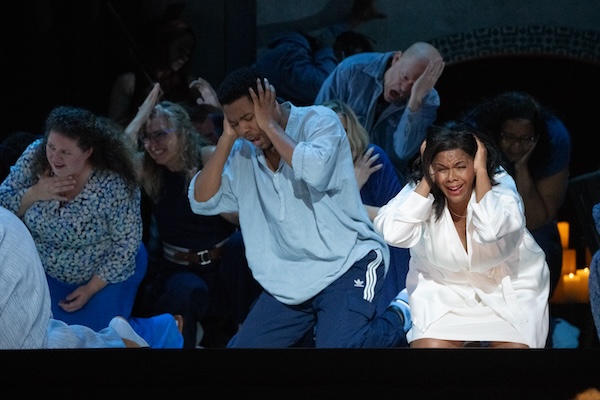
Photo: Steven Pisano
The goings-on inside the cult, which more or less account for the remainder of the opera, are rendered in such a staggeringly broad tone that it calls into question the intentions of the entire piece. Are we actually here to watch a farce about a cult? If so, it’s not very funny, the humor largely reliant on the audience tittering every time someone sings a profanity or some incongruous piece of modern slang in their opera voice. Moreover, the scoring under this material remains deadly serious, resulting in a deadening tonal mismatch with the hijinks onstage.
Or are we still supposed to be earnestly engaging with the piece as a story about the collective dynamics that draw people into cults and empower charismatic figures? At least according to the program notes, the creators very much want us to take those aspects of the work seriously, and claim inspiration with the real and fictional stories about cults that have become pop culture phenomena in recent years.
So it is baffling that there seems to be such little understanding of the common thread that makes the best of that material so gripping: the ability to show how a rational person could find a cult-like dynamic appealing and seductive. The Listeners feels more like the take on a cult you’d get in a mid-90s Saturday Night Live sketch.
The tonal shift also irretrievably distances us from any sympathy that might have been built up for Claire and the other characters caught up in the snare. Howard Bard (confidently but unevenly sung by bass Kevin Burdette) is presented as such an obviously malign buffoon that it becomes impossible to identify with anyone who would fall under his spell. The Listeners badly misjudges the balance it needs to achieve with this crowd-pleasing material to retain any authentic investment in the characters’ stories.
Act II is more of the same. There are some appealing choral and ensemble passages for the assembled cult members (prepared by Elizabeth Braden) that hint at the appeal of the cult through voices carefully interlaced over shimmering strings, but these are ruthlessly undercut with easy bits that assure the audience nothing on stage should be taken too seriously. There is a paint-by-numbers love triangle and inevitable falling out.
The production and score try very hard to make some kind of a dramatic reckoning out of a scene where one of the cult members is ostracized. But these machinations come across as recycled plot points of “stuff that happens in a cult” rather than anything unique to this story.
We also get three plaintive video monologues for Claire, Angela, and Kyle about their respective traumas and disappointments, all well performed by the artists. Thelwell’s heartfelt and probing reading of Angela’s scene in particular stands out against the absurdity her character elsewhere. But characters deal with their problems in all sorts of ways and telegraphing the generic idea that emotionally unfulfilled people might be drawn to cults feels like a pat attempt to shore up the characters’ motivations.

Photo: Steven Pisano
More filler also creeps into the libretto in Act II, like a repetitive monologue for that one rogue cult member, sung with plenty of fury and commitment by bass John Moore, that devolves into a laundry list of paranoid fantasy tropes. Or several segments for a TV news reporter character (Guadalupe Paz) which seem included just for the opportunity of showing a fake news feed on the projection.
Corrado Rovaris led the Opera Philadelphia Orchestra in a precise reading of Mazzoli’s score—finely balancing colorful textures against the muscular string lines and realizing the quick turns from spiky accompaniment to gushing emotional moments. Bravura passages for horns and tight percussion interruptions further showed the band expertly conquering the work’s musical demands.
The physical production, directed by Lileana Blain-Cruz with a set designed by Adam Rigg, and lighting by Yi Zhao, seeks to capture the southwest setting with backdrops and evocative twilight colors. Yet the ambition to literally realize so many of the settings, through different rooms placed on a revolve, feels overly cumbersome for the slight material and oddly shoehorned beneath masking used for the projections. Simpler and more elegant solutions to the staging might have allowed for a stronger point of view to enhance the look and feel of the piece.
The liberally used projections, designed by Hannah Wasileski, are most effective when they are focused on those simple black and white high-definition feeds of the cast members faces; other uses, like the aforementioned newscasts and the cult’s ham-fisted attempt to do a Tik Tok video feel extraneous.
The Listeners runs through September 29 at the Academy of Music in Philadelphia. operaphila.org
